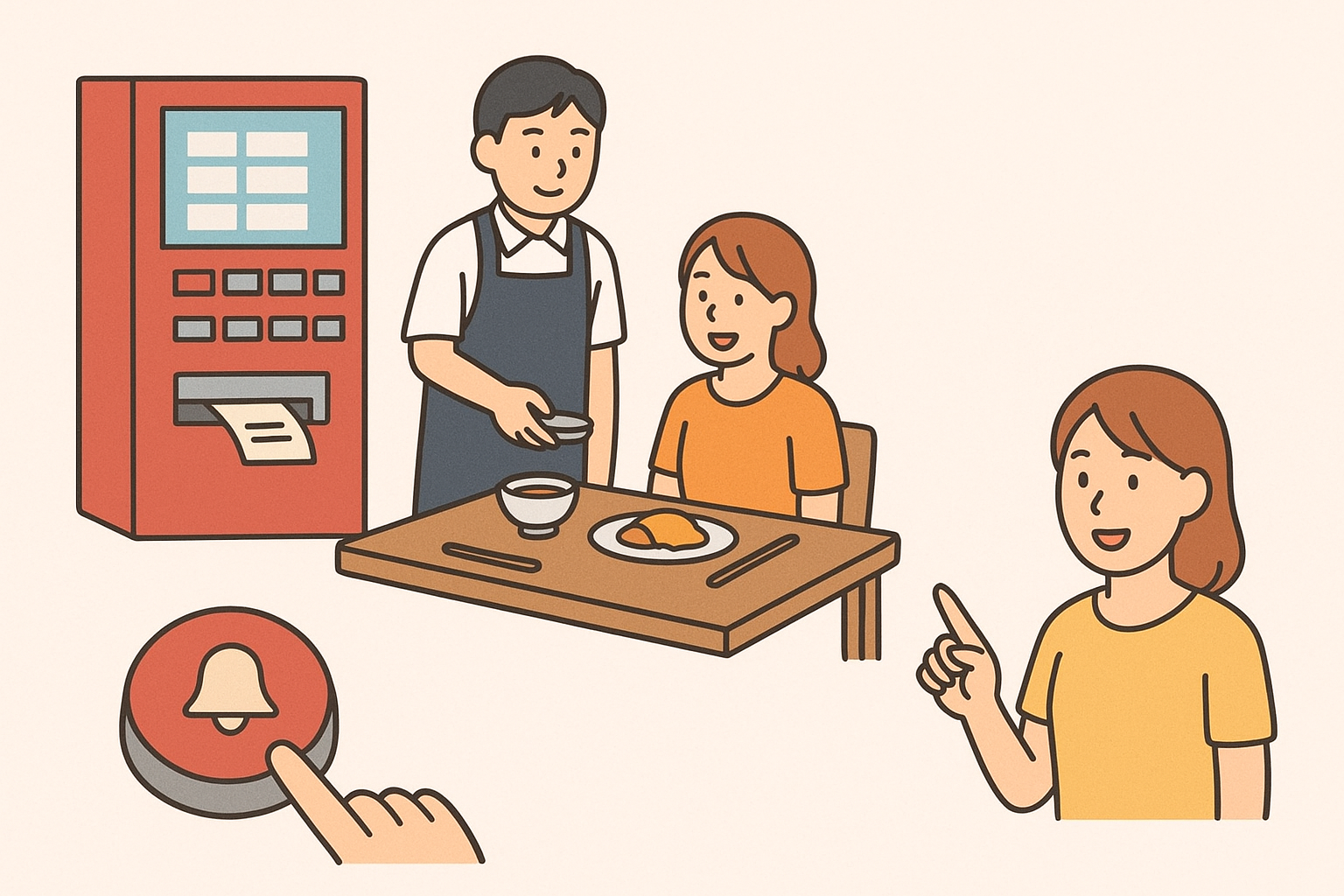When visiting Japan, one of the most common challenges for international travelers is figuring out how to order food at Japanese restaurants.
From ticket vending machines to table charges (“otoshi”) and call buttons, Japan has its own unique dining customs that may seem confusing at first.
This guide breaks down everything you need to know about ordering, paying, and enjoying your meal smoothly — so you can focus on tasting Japan’s amazing local food and soaking up the culture.
1. Start with the Vending Machine: Ordering in Ticket-Based Restaurants
In Japan, especially at ramen shops or casual eateries, you’ll often see a vending machine near the entrance.
Instead of ordering from a waiter, you’ll buy a ticket (“shokken”) first — just press the menu button with the photo of the dish you want, pay with cash or e-money, and hand your ticket to the staff.
Tips:
- Simply give your ticket to the staff — no need to order verbally.
- Some machines let you add toppings, so double-check the screen.
- Many now include English menu options (look for a language button on-screen).
Traveler advice:
Don’t stress if you hesitate at the machine! Even if there’s a line, a quick “Sorry!” will usually get you friendly help from the staff.
2. Understanding “Otoshi” and Table Charges in Japan
At izakaya (Japanese pubs), you might be served a small dish when you sit down — even if you didn’t order it.
This is called “otoshi”, a small appetizer that doubles as a table charge (seat fee).
While this may surprise first-time visitors, it’s an established part of Japanese dining culture.
What to know:
- The otoshi fee is usually ¥300–¥600 and cannot be refused.
- It may appear on your bill as a “seat charge.”
- Common in bars and izakayas, but not in cafes or most restaurants — so don’t worry if you prefer casual dining.
3. Calling the Server: Use the Call Button or a Friendly “Sumimasen!”
In Japan, servers don’t hover at your table.
If you see a call button on your table, press it to signal the staff.
If there’s no button, simply call out “Sumimasen” (excuse me) — it’s perfectly polite.
In quiet cafes or upscale restaurants, a simple hand raise and eye contact works better.
The key is reading the atmosphere and matching your approach to the restaurant’s vibe.
4. Don’t Speak Japanese? No Problem — Try the “Point and Order” Method
Even if you don’t speak Japanese, you can easily order by pointing at menu photos and saying:
“Kore kudasai” (This one, please).
Many local restaurants don’t have English menus, but staff are usually kind and patient.
As long as you smile and show appreciation, you’ll have a great experience.
💡 Pro tip: In Japan, politeness matters more than perfect Japanese — a friendly attitude goes a long way!
5. Paying Your Bill: At the Register, Not the Table
After finishing your meal, take your bill slip (“denpyō”) to the register — table-side payment is rare.
Nowadays, credit cards and mobile payment apps (like PayPay or Alipay) are accepted at many places, but small restaurants and ticket-based spots often take cash only.
It’s smart to keep around ¥2,000 in cash(It may vary depending on the restaurant and how much you eat.) for meals, just in case.
Conclusion: Enjoy Japan’s Unique Dining Culture
Japanese restaurants may feel full of rules at first, but once you get the hang of it, everything runs smoothly.
From vending machines to call buttons, every detail is designed to make your dining experience efficient and comfortable.
Food is one of the highlights of any Japan travel adventure — so embrace the local customs, and you’ll discover just how enjoyable dining in Japan can be!
Whether it’s ramen, sushi, or izakaya bites, use this guide to eat like a local and make the most of your culinary journey in Japan.
